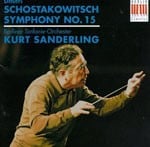2.picc.2.2.2-4.3.3.1-timp.perc:tgl/whip/wdbl/tom-t/SD/BD/cyms/tam-t/glsp/xyl/vib-cel-strings(16.14.12.12.10)
Abbreviations (PDF)
VAAP
In some ways, the Fifteenth is the most neo-classical of all Shostakovich’s symphonies. It is, at least in certain moments, his tribute to the world of Haydn, Mozart and Beethoven. It is scored for a modest-sized orchestra and consists of four movements which follow, more precisely and yet more whimsically than any other of his symphonies, the ancient outlines: a gossamer and comical first movement, playing in an almost childlike way with the signposts of sonata form; a sombre slow movement; a dancing and elusive scherzo; and, after a mysterious introduction, a last movement miraculous in its fluidity and its unearthly sense of bright light playing on a surface beneath which lurk great depths of darkness.
The Fifteenth was undoubtedly intended as a summing-up, a survey by a sick and slowly dying man of a lifetime of musical experience. It also shows his vast knowledge of the medium and the history of the form. And it is packed with references to most of his own earlier symphonies, almost as though at this critical point he were looking back at himself, both as hero (the brilliant and fearless youngster who gave birth to the astonishing First Symphony, the heroic master of the Fourth and Fifth) and as anti-hero (the many disappointments, terrors and frustrations).
More surprisingly it contains, in a manner blatant and unnervingly provocative, a bizarre sequence of the most surprising quotations found anywhere in his output. In the first movement of the Fifteenth, without warning, the brass section of the orchestra lurches sideways into an absurd firemen’s-band version of Rossini’s ‘William Tell’ Overture. By contrast, the last movement opens with two extremely loaded quotations from an entirely unexpected source: Wagner. Nothing in Shostakovich’s earlier music had prepared listeners for this sudden interest in the Master of Bayreuth. The first reference is to the moment in ‘Die Walküre’ when Brünnhilde appears to the fleeing Siegmund. She has been sent to tell the unhappy warrior that he must die. This haunting chain of suspensions interrupted by menacing beatings of the kettle-drum is then folded by Shostakovich into a quite different Wagnerian quotation, the famous opening notes of ‘Tristan und Isolde’. And then, more bizarrely still, the ‘Tristan’ quotation itself blossoms into a garbled version of a beautiful song by Glinka, setting words by one of the greatest poets of early Russian romanticism, Yevgeny Baratynsky:
Do not tempt me needlessly
By returning to your former tenderness.
To a disillusioned man
All the old seductions are alien.
It is clear that Shostakovich intends every move he makes in this symphony to be loaded with specific significance.
Note by Gerard McBurney

Galina Vishnevskaya (soprano), Mark Reshetin (bass), cond. Mstislav Rostropovich
0090432BC
